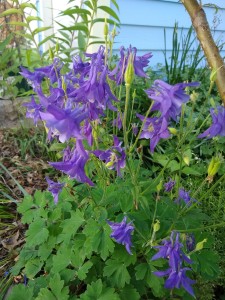
I have columbine or Aquilegia vulgaris growing in my garden—and occasionally in the grass, rock wall crevices, cracks between pavers, and just about anywhere else that that is home to more than an atom of soil. I regard this as a blessing, because most of them are self sown specimens that flourish with absolutely no help and very little attention from me.
The only thing that makes the columbine situation less than optimal is that about ninety percent of my columbines are blue or more properly, dark, blue-purple. This is not a bad color, but I do occasionally wish for more variety.
The lack of other colors is not for want of trying. Over the years I have bought numerous columbines in all the available shades , from pure white to yellow, a range of blues and purples, as well as red. A few whites have continued to do battle with the blue columbine population, and in a raised bed, somewhat removed from the blues, some pink, double “granny’s bonnet” type plants flourish. Another pink, single-flowered plant is currently holding forth on my front strip. I am still waiting to see whether the yellow Aquilegia chrysantha or golden columbine that I bought a few years ago at a plant sale will show up this spring. But mostly, my columbines are as blue as a bluefish and going strong.
This phenomenon is most likely about genetics. Clearly the genes for blue coloring are the strongest among the columbines growing in my garden. I don’t believe soil chemistry, which can change the color of hydrangeas, has any influence on the aquilegia genus. It is ironic that my rapacious Spanish bluebells or Hyacinthoides hispanica, which I would love to see blooming in blue, come up mostly pink, in the same spaces where pink columbines are unable to achieve hegemony.
As the Rolling Stones sang long ago, “You can’t always get what you want, but if you try sometime, you find you get what you need.” Clearly I must need blue columbines.
The genus is endemic to the northern hemisphere, with species originating here and in Europe. The flowers bear little resemblance to their many kin in the buttercup or Ranunculaceae family, but the relationship was established by botanists long ago. Slender flower stalks occasionally reach up to three feet tall, but are often shorter. Technically, each bloom has five petals, but there is a lot of variation within the columbine clan. Some varieties feature petals that have modified themselves over time into showy long spurs to attract hungry, nectar-seeking hawk moths. Others, like the double-flowered ‘Dorothy Rose,’ look like frilly boudoir lampshades, with heads chock full of densely packed petals. These extravagant varieties, more than other columbine types, have helped earn the nickname, “granny’s bonnets.” Still other types, like the pink and white favorite ‘Nora Barlow,’ feature a crowded array of fringed petals, reminiscent of small dahlias or mums.
The name “columbine” comes from the Latin word for “dove” and may have been bestowed on the plants when someone decided that the pendulous flowers resembled groups of those birds. Perhaps some near-sighted flower lover with a poetic imagination and a stand of white flowered columbine was responsible. The Latin species name, “Aquilegia”, means “eagle-like.” This came from the great eighteenth century botanist, Linnaeus, who saw a resemblance between the petal configuration, which features sharply pointed petal ends, and eagles’ claws. Doves or eagles? It depends entirely on your sensibilities and poetic disposition. Either way, the flowers are winsome and beautiful, dancing in the spring breezes.
When not in bloom—or in my case “in blue”—the plants are still good looking. After the flowers disappear, the tall seed heads add interest until they turn brown and spill copious amounts of seed on the surrounding earth. The leaves are almost as beautiful as the flowers–dark green or blue-green, tri-lobed and fan-shaped, they persist through the growing season. They are occasionally troubled by leaf miners, whose depredations create swirling white lines on the leaf surfaces. It is probably sacrilege to say so, but I find the leaf miners’ trails almost attractive. Leaf miners may cause some leaf drop, but no permanent damage to healthy plants. For those of us troubled by both shade and varmints, columbines are a blessing. They thrive in consistently moist, semi-shaded places and seem to be relatively resistant to deer interference. They do attract hummingbirds and other pollinators and look equally alluring in indoor arrangements.
At this time of the year, columbines in all colors are available everywhere, from big box stores to specialty retailers, both “bricks and mortar” and online. For an interesting selection of varieties to grow from seed, try Select Seeds, 180 Stickney Hill Road, Union, CT 06076;
1-800-684-0395; www.selectseeds.com. Free print catalog.

